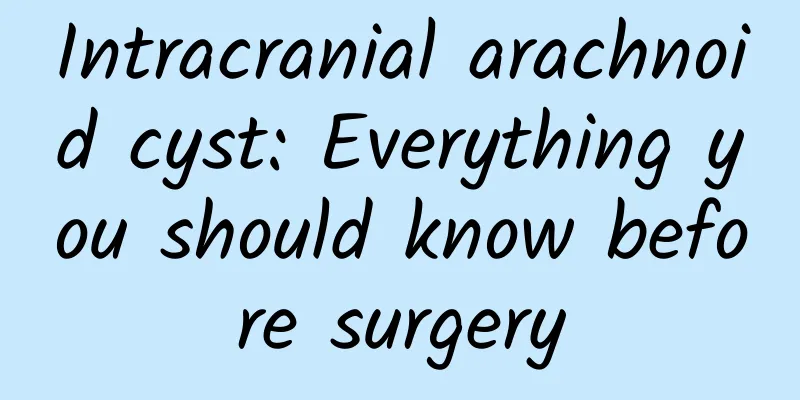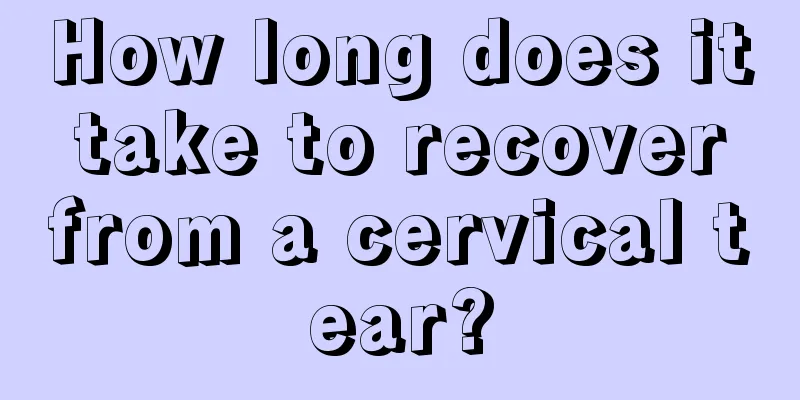Intracranial arachnoid cyst: Everything you should know before surgery

|
Author: Tian Yongji, Chief Physician, Beijing Tiantan Hospital, Capital Medical University Reviewer: Li Jingjing, Chief Physician, Beijing Tiantan Hospital, Capital Medical University Arachnoid cyst is a common intracranial lesion, usually formed by the accumulation of cerebrospinal fluid in a certain part of the subarachnoid space. Although most patients with intracranial arachnoid cysts may not have obvious symptoms, surgical treatment is often necessary for some patients with clinical symptoms. 1. Indications for surgery for intracranial arachnoid cysts The surgical treatment of intracranial arachnoid cysts cannot be generalized, but requires personalized evaluation based on the patient's specific circumstances. Generally speaking, surgical treatment is mainly for the following situations: First, when the cyst causes clear clinical symptoms, such as severe headache, nausea, and vomiting, and imaging shows that the cyst compresses brain tissue, midline shifts, or skull bulges significantly, surgical intervention can be considered. Secondly, if the cyst causes epilepsy and the EEG confirms that the epilepsy originates from the cyst site, there is also an indication for surgery. Finally, when the cyst spontaneously ruptures and bleeds, forming an intracystic hematoma or subdural hematoma, emergency surgery is also required. It is worth noting that cyst size is not the only criterion for surgery. Even if the cyst is large, as long as the patient is asymptomatic and does not affect normal life, regular follow-up is usually adopted instead of immediate surgery. The follow-up interval can be adjusted according to the patient's age and the stability of the disease to ensure timely monitoring of changes in the cyst. 2. Surgical methods and options for intracranial arachnoid cysts The surgical treatment methods for intracranial arachnoid cysts mainly include craniotomy, neuroendoscopic neurostomy (endoscopic neurostomy) and cyst-peritoneal shunt (shunt surgery). Each surgical method has its specific application scenarios and advantages and disadvantages. 1. Craniotomy: As a traditional surgical method, craniotomy directly opens the cranial cavity to expose and treat the cyst. It is no longer the preferred surgical method because craniotomy is more traumatic and has a higher incidence of complications. However, in some special cases, such as when endoscopic fistula or shunt surgery is ineffective, repeated bleeding in the cyst, inflammation or adhesion in the cyst, and other complex conditions, craniotomy is still a treatment method. 2. Neuroendoscopic fistula surgery (endoscopic fistula surgery): This is a more commonly used surgical method. Through endoscopic technology, a small hole is drilled in the skull, and the endoscope is inserted into the cyst area to create a fistula on the cyst wall, that is, a small incision is made to establish communication between the cyst and the surrounding brain pool or brain groove, so that the fluid in the cyst can pass through the fistula and participate in the entire cerebrospinal fluid circulation, thereby reducing the pressure in the cyst and gradually shrinking it. This method has less trauma and quick recovery, and is currently the preferred surgical method. Figure 1 Original copyright image, no permission to reprint 3. Cyst-peritoneal shunt (shunt surgery): A shunt device is installed between the cyst and the abdominal cavity, so that the fluid in the cyst can slowly flow into the abdominal cavity and be absorbed by the abdominal cavity. This method is suitable for some situations that are not suitable for endoscopic fistula surgery, but its shortcomings are also very obvious, such as dependence on the shunt tube, the inability to remove the shunt tube, and the need to carry it for life. Figure 2 Original copyright image, no permission to reprint When choosing a surgical method, the doctor will conduct a comprehensive assessment based on the patient's specific situation. If the cyst has clear symptoms and is considered to require surgical intervention after rigorous evaluation, endoscopic fistula surgery is the first choice. If endoscopic fistula surgery is not effective or there are other special circumstances, such as bleeding or inflammation in the cyst, craniotomy or cyst-peritoneal shunt may be required. 3. Precautions after surgery for intracranial arachnoid cyst Endoscopic cystic cisternstomy is a minimally invasive surgery with a rapid recovery, but it still needs to be treated with caution. In the early postoperative period, medical staff will pay close attention to the patient's vital signs and neurological condition to ensure a smooth transition. In home care, temperature monitoring and wound observation are key to timely detect and deal with possible inflammatory reactions and wound abnormalities. Most patients can recover quickly about a week after surgery, but there are significant individual differences. If complications such as infection occur, the recovery period will be prolonged. Follow-up examination is an indispensable part after surgery. The first follow-up is usually scheduled one month after surgery to monitor bleeding in the cyst, brain tissue repositioning, and subdural effusion. If the patient is stable after surgery, an evaluation will be conducted every three months. If the patient continues to be well, he or she can gradually resume normal life and adjust the frequency of follow-up according to the doctor's instructions. The review included head circumference measurement, wound healing observation, and cranial magnetic resonance imaging (MRI) examination to evaluate cyst volume changes and potential complications to ensure surgical effectiveness and patient safety. |
<<: A must-read for parents: Is intracranial arachnoid cyst really an “invisible bomb”?
>>: Pessimistic, sad, and want to cry, is this depression?
Recommend
Homemade Shampoo Recipe
I believe that everyone cannot live without shamp...
Can fitness help enlarge breasts?
In the gym, you can often see many women doing fi...
How long is the best time to have sex after a normal birth
After giving birth, a woman's vagina and uter...
Early pregnancy symptoms left lower abdominal pain
In the early stages of pregnancy, since the fetus...
What should you pay attention to when cervical mucus plug flows out?
Many pregnant women need to pay attention to many...
I took ceftriaxone but my period didn't come
Cephalosporins are drugs used to fight bacteria, ...
What are the symptoms of pregnancy? Are you affected?
Many women are pregnant but do not discover it ea...
The two lines on the ovulation test paper are the same depth
A normal woman's body will release eggs, whic...
What should I do if I get pregnant less than a year after having a caesarean section?
What should I do if I get pregnant again within o...
What anti-inflammatory medicine is good for gynecological inflammation?
Gynecological inflammation is a common disease am...
If someone around you suddenly feels dizzy and nauseous, how should you provide first aid?
Author: Tang Qin, Deputy Secretary-General of the...
Why do women have backache and leg pain?
Many times people always encounter the problem of...
There is only one benefit of eating camellia oil, and it’s different from what you think!
Camellia oil is a nutritious cooking oil, and its...
Is it normal to not have your period for 35 days?
For women, it is normal for their menstruation to...
The bleeding was bright red on the third day after the abortion
If a woman has undergone medical abortion, she sh...









